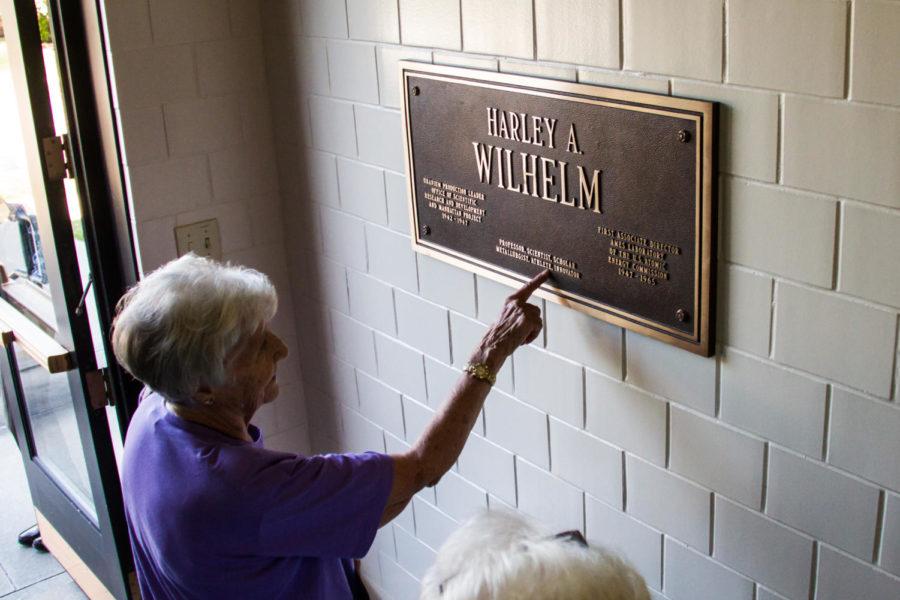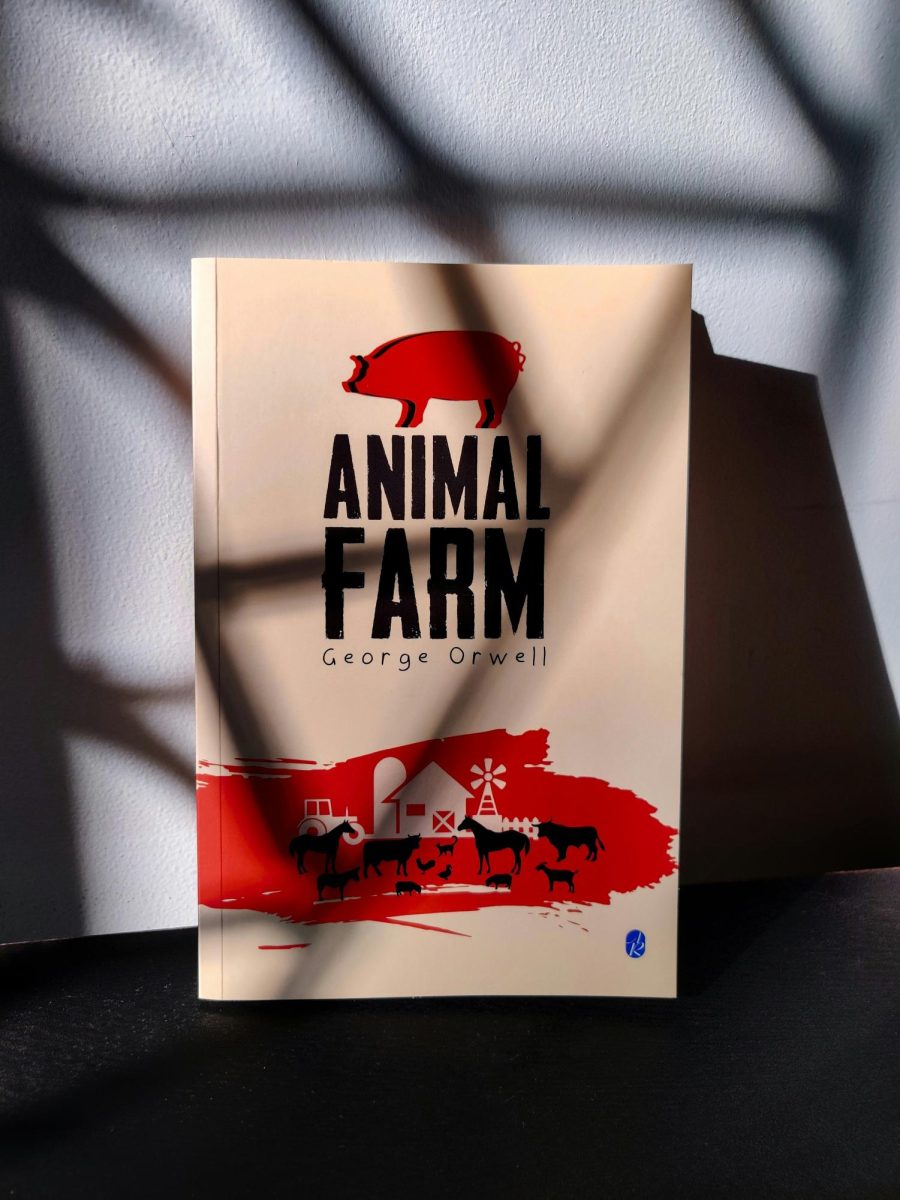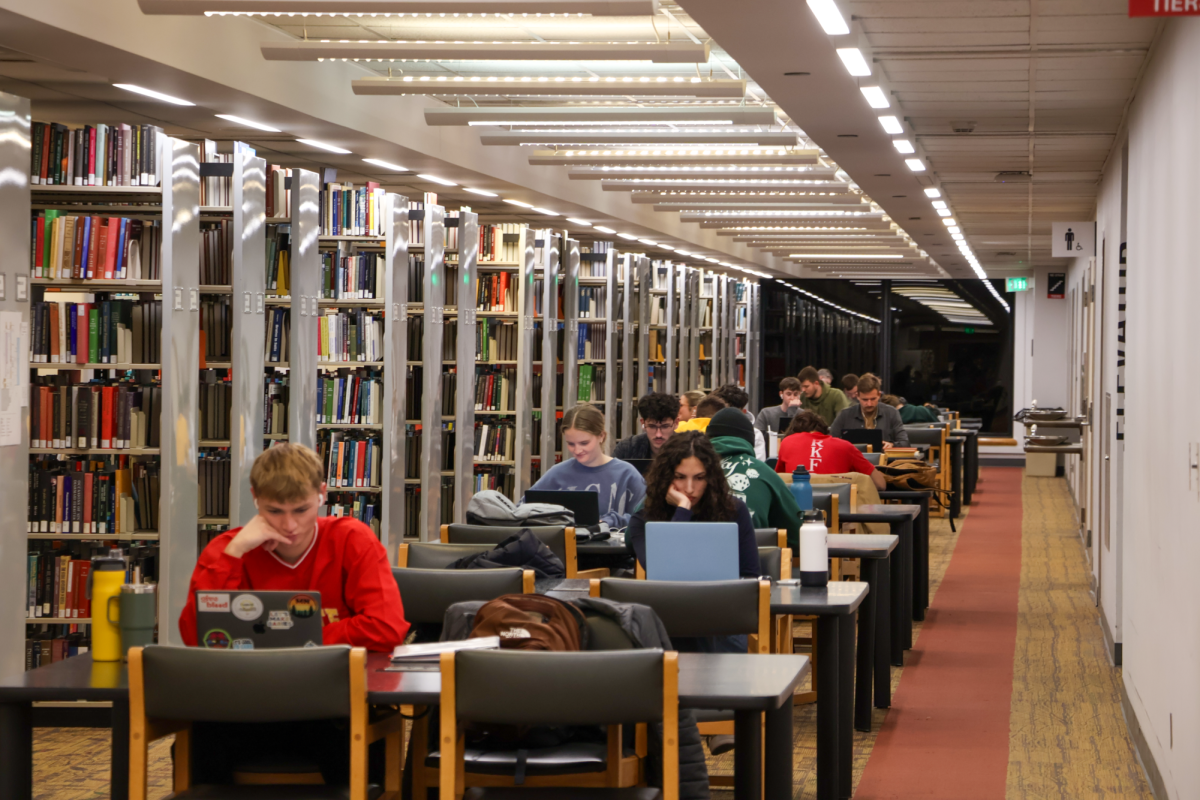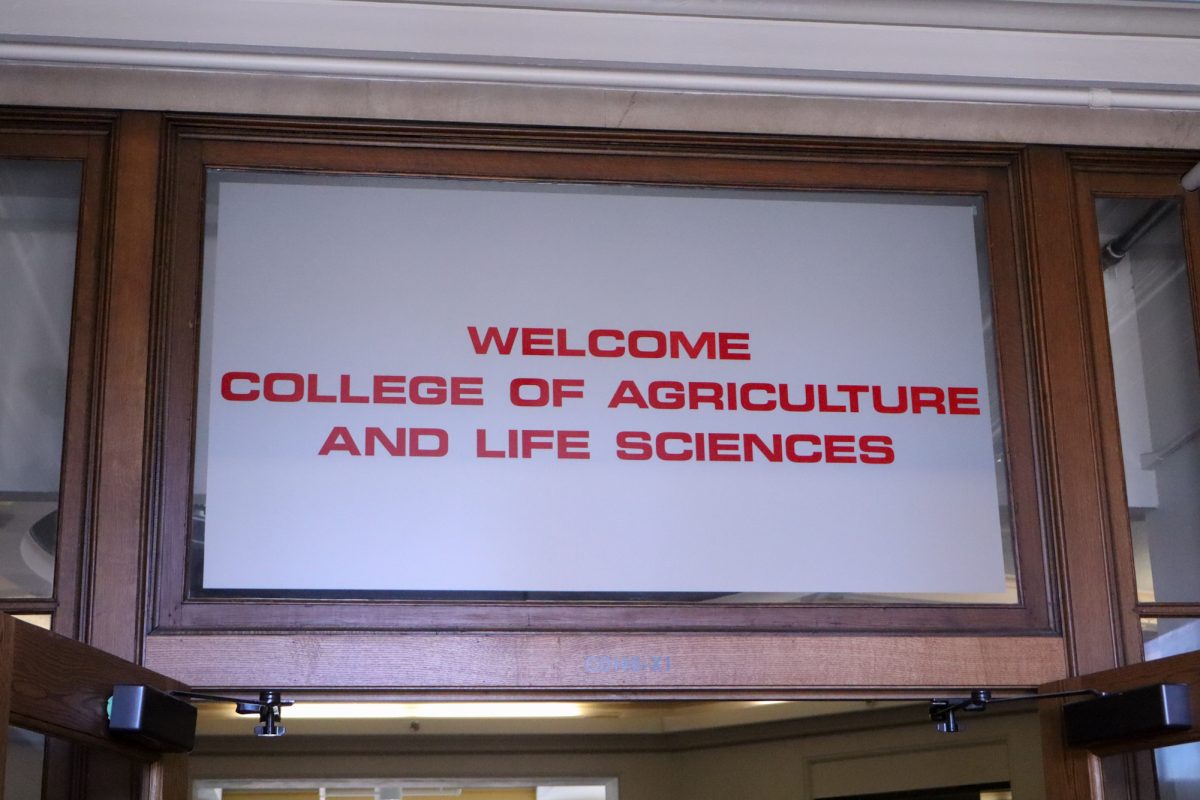Wilhelm family remembers father’s legacy
Myrna Wilhelm Elliott marvels at a plaque inside Wilhelm Hall displaying her father’s name and his achievements, during a visit on Sep. 9.
September 16, 2015
When Lorna Wilhelm Livingston sat down with her father for breakfast one day, she asked him in all seriousness, “Dad, what do you really do?”
Normally, this question would not be an issue for a father to answer his daughter. However, for Harley Wilhelm, it was.
All of his children, including Lorna, understood that their father was working on a project at Iowa State, but it was something they were told not to talk about.
But on that day while Lorna was in college, Harley Wilhelm said he would give his daughter three ideas.
“Say a ship is going across the ocean and it disappears,” he told her. “Or, let’s say New York City is there today, but it’s not there tomorrow.”
“You’re making a bomb,” Lorna said.
“I must have been right,” she said, 70 years later. “He never gave me the third option.”
Wilhelm was in fact building a bomb. In the midst of World War II, safe from the conflict in Ames, he led the research taking place at Iowa State that changed the world.
U.S. military bombers dropped the world’s first atomic bomb on the city of Hiroshima in Japan on Aug. 6, 1945 during the last year of World War II. Three days later, another bomb engulfed Nagasaki.
Wilhelm called his wife, who had no idea what Harley was doing at his job.
“Turn on the radio,” he said, disclosing his big secret. “This is what we’ve been working on.”
Wilhelm kept the secret of his work at the university for about three years. But as the city of Hiroshima was engulfed in an atomic blast, and the news raced across the world, he was released from keeping that secret.
Until that moment, however, Wilhelm could not reveal the facts of his job, let alone the existence of the Manhattan Project, even to his family.
The Wilhelm Children
Before coming to Iowa State, Wilhelm earned his undergraduate degree at Drake University. He eventually went on to earn his Ph.D. from Iowa State in 1931 and became an assistant professor in 1940.
He married Orpha Lutton in 1923, and together they had four children. Lorna, who was born in 1926, is followed by the only son Max, who was born in 1928. The younger sisters Myrna and Gretchen were born in 1929 and 1938, respectively.
As children, the Wilhelm siblings often spent time at their father’s office in the Chemistry building, which is now torn down. They would run the halls, squirting water from the fountain at each other, and playing tricks. Oftentimes, their father would give them clay to play with or new sticks of chalk to draw on the blackboards.
Myrna described her father as a curly-haired man who always seemed late and enjoyed playing the accordion and fiddle.
“He was a kidder,” she said. “But when he got serious, he got serious.”
Even 70 years later, the siblings share fond memories of their childhood spent on campus.
The Manhattan Project
In 1939, just before the start of WWII, scientists in Germany discovered a way to split the atom using neutrons. Kathy Svec, co-president of the Ames Historical Society said, when the atom split apart in the material uranium, they got a fizz. That fizz was energy releasing from the atom.
Shortly after, German forces invaded Poland and began the Second World War in Europe.
Svec said many scientists in Germany were Jewish and fled from the country out of fear.
“A number of them, including Albert Einstein, immigrated to the U.S. because it was safer for them there,” Svec said. “They brought with them the knowledge on how to split the atom and they also brought with them the fear that it would fall into Nazi hands.”
President Franklin D. Roosevelt received a letter from Einstein and other scientists in the U.S. that pleaded the president proceed with research on this discovery for military use.
Svec said FDR initiated the project that set in motion this incredible effort. Today, it is known as the Manhattan Project.
About 125,000 people were working on the project during this period on all different types of stages, Svec said. The majority of whom working in factories had no idea that their work contributed to a weapon of mass destruction.
“In this project, there were no boundaries,” Svec said. “It covered the entire United States.”
Iowa State’s role
One major problem the project faced was the need to create huge quantities of purified uranium.
Scientists were recruited by the military from universities, including Arthur Compton from the University of Chicago who headed the effort to covert the uranium to plutonium in order to design the atomic bomb.
However, in order to do this, large amounts of the purified uranium was needed. Compton recruited Frank Spedding, who was an expert in the rare earth chemistry and professor at Iowa State, to do just that.
The work began at Iowa State in 1942, Svec said.
Scientists at the university managed to discover a way to purify mass quantities of uranium at a very low cost, which greatly sped the progress of the project. Svec said scientists produced more than two million pounds of the purest uranium that had ever been produced in the world.
“Time was of the essence,” Svec said. “Every second counted because they didn’t know what the Nazis were doing and they needed to beat them.”
The researchers
The head researcher on the scene at Iowa State was Wilhelm, who oversaw the day-to-day research.
During the time of the project, Wilhelm was recruited as the associate director of the Metallurgical Laboratory to conduct research on uranium. He, along with the scientists who worked under him, created a way to purify the uranium needed for the atomic bomb to be successful.
“It was a job and he had the brainpower to do it,” Myrna said.
Svec’s father, Harry, joined the project later in 1944.
Harry Svec had been initially deferred from the draft in the early 1940s because he was teaching and doing critical research in rubber at the university.
As the U.S. military was preparing for D-Day in 1944, Harry Svec was ordered to report for duty. He was never sent overseas, however, because he was ordered to report to Frank Spedding at Iowa State. From there, he began to work on the project.
Secrecy
It wasn’t until Aug. 6, 1945, that Harley, Harry and hundreds of other people across the country were released from their shared secret about the Manhattan Project. But before that moment, it was of the gravest importance that no hint of their work reached the enemy overseas.
Svec said men who knew about the project’s endgame were threatened to keep the secret, or else they would be sent to the front lines of the conflict.
Svec’s father was among those under orders and could not even talk about his work with his wife, Edna.
“My mother used to talk about people who would say, ‘Why isn’t Harry in the Army?’” Svec said. “He was a young, draft-age guy who wasn’t going anywhere. A lot of these young guys were considered unpatriotic.”
The Wilhelm children were aware their father was working on something major, but Myrna said they knew better than to ask about it.
During the time of the project, half of the Chemistry building on campus was blocked off and under guard. Whenever she waited to drive home with her father, she had to stand by the door with the guard.
Lorna said they knew it was secret.
“When I was in high school, everyone knew there was secret stuff going on out there,” she said. “Everyone was asking me what he did. And I asked him, ‘What am I supposed to tell them?’ And he said, ‘You just tell them we’re making the Japanese nail polish.’”
Max said he never knew what was going on with his father’s work, but there were things that he saw.
He remembers one night driving with his father to Little Ankeny, the building where most of the work on the project took place.
Max stayed in the car, but he described the scene unfolding before him.
“I remember the whole side of [the building] was open and there were men pouring metal and there were sparks,” he said. “I found out later that they had these explosions there, so they made these walls and doors that blew out so they wouldn’t have to keep rebuilding.”
Little Ankeny was located south of Hamilton Hall on campus, and had a poor retention rate for its secretaries because of the frequent hazards of the work done there.
The moment the news broke about the explosion in Japan is clearly imprinted in the Wilhelm family’s minds.
Lorna, who was working in the dark room developing photographs for information services in the Memorial Union, heard the news on the radio.
“That’s when we knew what that was about,” she said.
The end result
The scientists at Iowa State finally saw the result of their nearly three-year labor in August 1945, the official end of World War II.
Although the nuclear bomb was dropped 70 years ago in August, its effects are still clearly felt today. The U.S. was launched into a Cold War with Russia, with the fear of a nuclear winter hanging over the heads of both countries and the rest of the world. Recently, President Obama signed a deal with Iran in order for the country to end its pursuit of nuclear weaponry.
At the time, however, it’s unclear if the leadership of the U.S. government and its military knew their success would affect international politics nearly 100 years in the future.
Lorna her father he told her he could foresee the future of atomic energy in agriculture, medicine, defense and in energy.
“Unfortunately, it had to, by necessity, be introduced in a negative fashion,” she said.
At the time, as the whole epic of the war was unfolding, the only thing that was clear in the minds of the people of the world was the need for the end of the conflict.
Svec said the knowledge of what the Nazis were doing to the Jews was coming out and the Japanese were expanding all throughout the Pacific.
“The toll, the expense and the human cost of the war was so unbelievable,” Svec said. “People at that time, they were desperate for anyway to make it end.”
Even though the Germans surrendered before the bomb was really ready, the culture of the Japanese would not allow them to give up, Svec said.
“They were going to fight to the last man,” she said. “In 1945, the U.S. military was poised to invade Japan. They were estimating that it would be over a million casualties in the process of invading Japan.”
Max said there was nothing but joy at the time because the war was over.
“As far as killing innocent people, Hitler started doing that when he was bombing London,” he said. “Thousands of people were killed in Europe. It was just more of the same.”
Myrna said everyone hated the Japanese and Germans at the time because they were the enemies.
“So many of my friends’ older brothers were in the service who were killed,” Myrna said. “When you see all of your friends’ brothers dying, you wanted the war to end. You’re glad that it’s over.”
When considering the lives lost, it was slaughter for both sides, Myrna said.
“I think war is useless,” she said.
However, Myrna said she sees that less lives were killed this way, because the invasion would have just taken out another generation of kids.
Gretchen said it saved so many more lives than it took.
“It saved a lot of Japanese [people’s] lives as well our own,” she said. “The bomb was terrible, but war is terrible.”
Lorna said her father’s work is a source of great pride for their family, and they hope to keep his memory and his accomplishments alive.
“The future of atomic energy was wonderful for the world; it still is to this day,” Lorna said.







